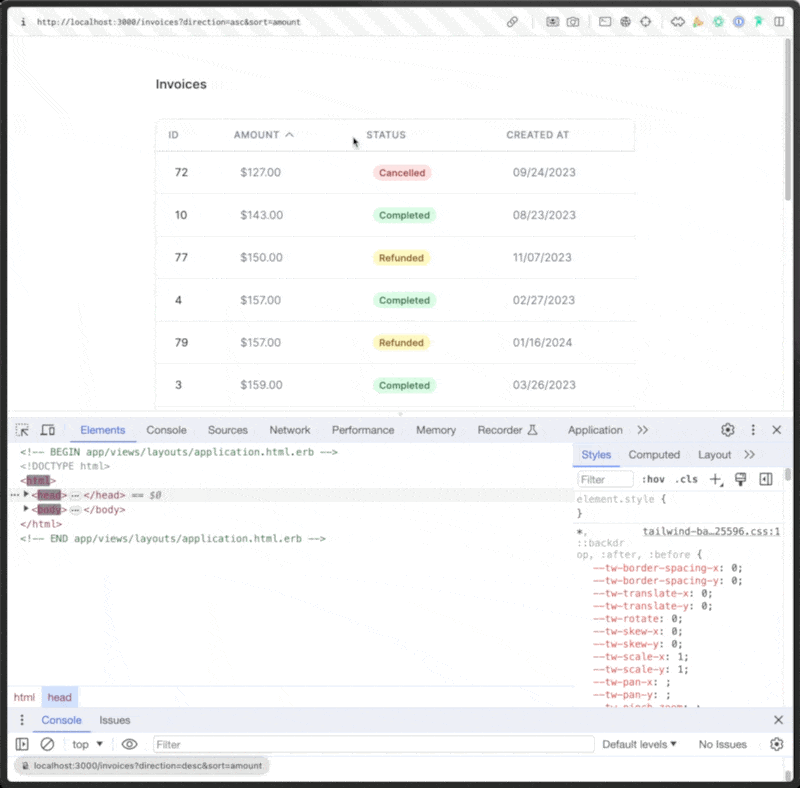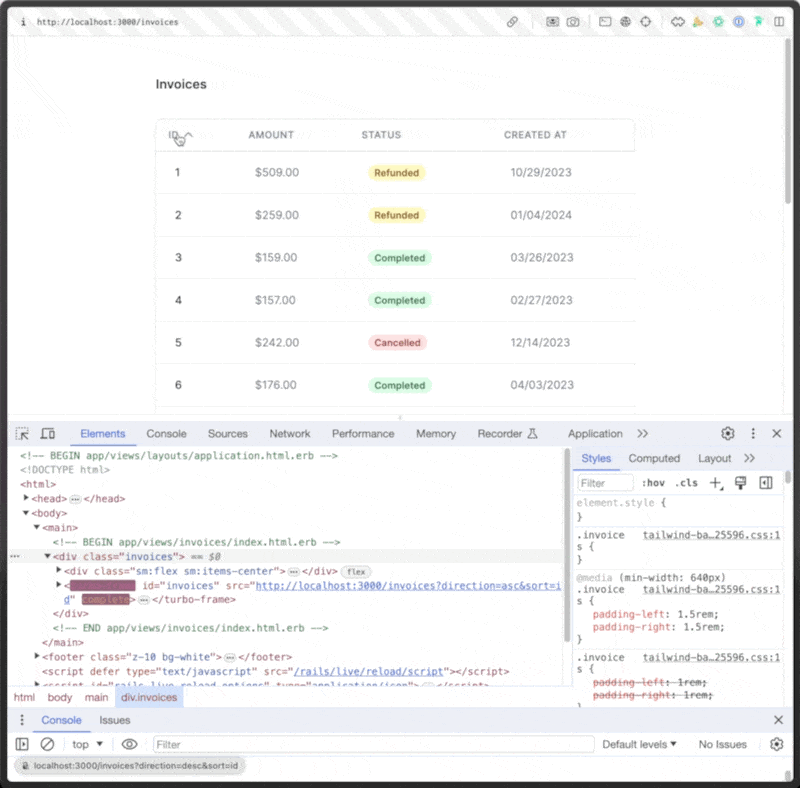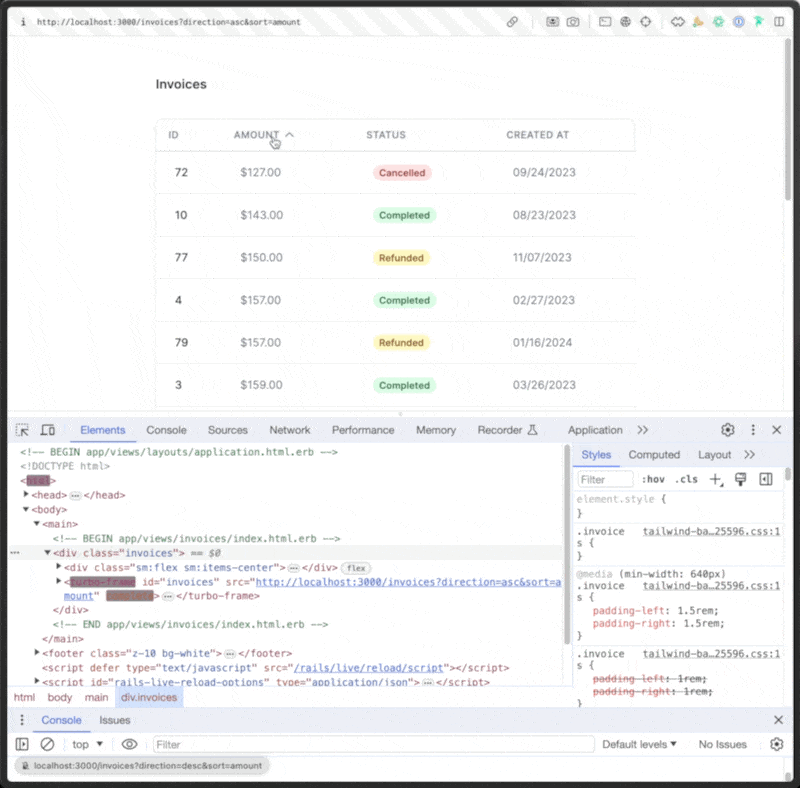Turbo Sortable Paginated Tables
 Avi Flombaum
Avi FlombaumWe're going to build a common UI pattern: a sortable, paginated table using the power of Ruby on Rails and Turbo Frames.
Sortable Table Headers
The first step is to create the sortable table headers as simple links. I wrote a few helper methods in Ruby to make this easier.
module ApplicationHelper
def sortable_table_header(title, column, path_method, **)
content_tag(:th, class: "invoices__th") do
sortable_column(title, column, path_method)
end
end
def sortable_column(title, column, path_method, **)
direction = (column.to_s == params[:sort].to_s && params[:direction] == "asc") ? "desc" : "asc"
query_params = request.query_parameters.merge(sort: column, direction: direction)
path = send(path_method, query_params)
link_to(path, class: "flex items-center", **) do
concat title
concat sort_icon(column)
end
end
def sort_icon(column)
return unless params[:sort].to_s == column.to_s
if params[:direction] == "asc"
svg_icon("M5 15l7-7 7 7")
else
svg_icon("M19 9l-7 7-7-7")
end
end
def svg_icon(path_d)
content_tag(:svg, xmlns: "http://www.w3.org/2000/svg", class: "ml-1 inline w-4 h-4", fill: "none", viewBox: "0 0 24 24", stroke: "currentColor") do
"<path stroke-linecap='round' stroke-linejoin='round' stroke-width='2' d='#{path_d}'></path>".html_safe
end
end
end
The important one is sortable_column which creates the link to with the sort and direction query parameters. With that method, we can make each table header a link to sort the table by that column, alternating between ascending and descending order. In our main view, we can use it like this:
<thead class="invoices__thead">
<tr>
<%= sortable_table_header 'ID', :id, :invoices_path, class: 'invoices__row--header' %>
<%= sortable_table_header 'Amount', :amount, :invoices_path, class: 'invoices__row--header' %>
<%= sortable_table_header 'Status', :status, :invoices_path, class: 'invoices__row--header' %>
<%= sortable_table_header 'Created At', :created_at, :invoices_path, class: 'invoices__row--header' %>
</tr>
</thead>
Now when you click on a column header, the table will be sorted by that column by making a full request to the server and redrawing the entire page, you know, the way links work out of the box. We'd also have to update our controller code to support the sort and direction params, so let's do that.
class InvoicesController < ApplicationController
def index
sort_column = params[:sort] || "created_at"
sort_direction = params[:direction].presence_in(%w[asc desc]) || "desc"
@invoices = Invoice.order("#{sort_column} #{sort_direction}").page(params[:page]).per(10)
end
end
I'm using the kaminari gem for pagination, so I'm using the page and per methods to paginate the results. The order method is used to sort the results by the column and direction specified in the query parameters. It works pretty well out of the box.
This is the nice, classic, beauty of Ruby on Rails. Clean backend code written in Ruby to do the heavy lifting, and simple, clean HTML to render the table.
The only issue is that as you can see, every time we click on a column header, the browser is redrawing the entire page. Notice the html, head, and body tag being updated?
That means that any other content on the page that won't need to be updated from the new request is redrawn anyway.
In the spirit of reactive applications, we want to alter the dom as little as possible to keep the user experience smooth and fast and only redraw the updated part of the page, the table. That's where Turbo Frames come in.
Turbo Frame Table
We're going to wrap the entire table in a turbo frame. A turbo frame is a container that can be updated without a full page reload. It's a way to make a part of the page reactive, but without the complexity of a frontend framework or even any change to our backend at all.
<%= turbo_frame_tag "invoices" do %>
<div class="flow-root mt-8">
<div class="-mx-4 -my-2 overflow-x-auto sm:-mx-6 lg:-mx-8">
<div class="inline-block min-w-full py-2 align-middle sm:px-6 lg:px-8">
<div class="invoices__table--shadow">
<table class="invoices__table">
<thead class="invoices__thead">
<tr>
<%= sortable_table_header 'ID', :id, :invoices_path, class: 'invoices__row--header' %>
<%= sortable_table_header 'Amount', :amount, :invoices_path, class: 'invoices__row--header' %>
<%= sortable_table_header 'Status', :status, :invoices_path, class: 'invoices__row--header' %>
<%= sortable_table_header 'Created At', :created_at, :invoices_path, class: 'invoices__row--header' %>
</tr>
</thead>
<tbody class="invoices__tbody">
<% @invoices.each do |invoice| %>
<tr>
<td class="invoices__row invoices__row--id">
<%= invoice.id %>
</td>
<td class="invoices__row invoices__row--amount">
<%= number_to_currency(invoice.amount) %>
</td>
<td class="invoices__row invoices__row--status">
<%= status_badge(invoice.status) %>
</td>
<td class="invoices__row invoices__row--created-at">
<%= invoice.created_at.strftime('%m/%d/%Y') %>
</td>
</tr>
<% end %>
</tbody>
</table>
</div>
</div>
</div>
<%= paginate @invoices %>
</div>
<% end %>
The cool thing is that any link within the turbo frame when clicked will automatically change the source property of its parent frame to the href of the link. This means that when we click on a sortable column header, the turbo frame will automatically update itself with the new sorted table. No need to write any JavaScript or even any additional backend code. It just works.
With the update, the browser is no longer redrawing the entire page. It's only redrawing the turbo frame, which is the table. This makes the user experience much smoother and faster and means any other content on the page will be maintained and not rerendered or anything. It's just way less work for the browser.
That's really it. The only issue is that clicking on a column header doesn't change the URL, so you can't share the state of the sorted table with anyone. But fixing that is easy with Turbo. By adding a data-turbo-action="advance" attribute to the link, we can change the URL without a full page reload, essentially advancing the page state to the new sorted table URL, but only redrawing the turbo frame.
I updated the sortable_column method to include the data-turbo-action attribute.
def sortable_column(title, column, path_method, **)
direction = (column.to_s == params[:sort].to_s && params[:direction] == "asc") ? "desc" : "asc"
query_params = request.query_parameters.merge(sort: column, direction: direction)
path = send(path_method, query_params)
link_to(path, data: {turbo_action: "advance"}, class: "flex items-center", **) do
concat title
concat sort_icon(column)
end
end
With that we can see that the URL changes when we click on a column header, but only the table is redrawn.
Now you can share the state of the sort with people.
Conclusion
I wish there was more to say about implementing this feature, it's just so simple and easy to do with Turbo and Rails. I also updated the pagination links to use the data-turbo-action="advance" attribute so that the URL changes when you click on a page number, but only the table is redrawn.
The rest of the code in the application is worth exploring for some nice BEM and Tailwind patterns, but the main feature is the sortable, paginated table. Checkout the final source:
- Sortable Table Helper
- Sortable Table View
- Sortable Table Controller
- Kaminari Pagination for Tailwind
- BEM Style Tailwind CSS Tables
You can checkout the full source code Github and play with it at Turbo Sortable Paginated Tables.
If you have any questions or comments or just liked the demo, feel free to reach out to me on X.
Subscribe to my newsletter
Read articles from Avi Flombaum directly inside your inbox. Subscribe to the newsletter, and don't miss out.
Written by

Avi Flombaum
Avi Flombaum
I'm an engineer, educator, and entrepreneur that has been building digital products for over 20 years with experience in startups, education, technical training, and developer ecosystems. I founded Flatiron School in NYC where I taught thousands of people how to code. Previously, I was the founder of Designer Pages. Currently I'm the Chief Product Officer at Revature.


